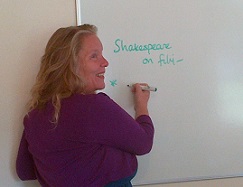
Dr Geoff Taggart is a lecturer in the Institute of Education and Programme Director for the Early Years Practice programme at Reading. As part of his secondment to the EMA programme, Geoff decided to run a focus group with students from the IoE to gather perspectives on electronic feedback and grading methods.
OBJECTIVES
To identify student views on:
• The perceived benefits of the three forms of most commonly- used feedback offered by Grademark (i.e. Quickmarks, rubrics and text comments)
• Preferences regarding the emphasis which each form of feedback should be given in a typical piece of work
• Views regarding the interrelationship of the different forms of feedback
CONTEXT
The focus group was composed of 4 MA students (2 international and 2 home), plus one Chinese academic visitor with recent experience of being a student. Their views were therefore representative of students engaged in social science disciplines and may not be transferable to other fields. Also in attendance were myself, Dr Maria Kambouri (engagement in feedback project) and Jack Lambert-Taylor (EMA). It took place at London Road campus between 5 and 6.30pm on Thurs 18th January.
IMPLEMENTATION
I provided participants with three copies of the same assignment, one marked exclusively with Quickmarks, one marked only with the final text comment and one marked solely according to the rubric. The purpose of this was to isolate and focus attention upon each of the three kinds of electronic feedback provided through the Feedback Studio.
The marking was not meant to be typical (nor as examples of best practice) but to highlight the positive and negative qualities of each kind of feedback. For example, there were a lot more quickmark comments appended to the assignment than would usually occur. The purpose of this was to emphasise both the positive benefits of maximised contextualised feedback and the negative impression of ‘overload’ which the comments could give. Additionally, the text comments amounted to over 2500 words and were extremely conversational and wide-ranging.
In a similar way, whilst this strategy deliberately emphasised the dialogical and personal nature of this feedback method, it was also not easy to straightforwardly pick out those points where the student needed to improve. By contrast, the rubric does this very clearly but is not a personal way of providing feedback.
REFLECTIONS
Quickmark feedback
• Students appreciated Quickmarks which contained hyperlinks (e.g. to Study Advice)
• One participant noted that they didn’t like the Quickmarks, on the basis that when printed the document does not have interactive links. The same participant suggested that excessive Quickmarks may be intrusive, and give the impression of ‘massacring’ a student’s work. They agreed that less excessive use would be preferable. The same participant noted that there was ‘no positive’ or ‘constructive’ feedback on the page- only problem points. This may be due to the nature of the sample work, which was deliberately of a poor standard; perhaps the same study should be conducted with a high quality piece of work.
• Another participant noted that narrative summaries can come across as more personal, particularly if negative, and that they preferred Quickmarks on the basis that they provided a more objective tone. Another participant suggested that Quickmarks may come across as more ‘humane’ on that basis, rather than a ‘rant at the end’.
• Another participant suggested that Quickmarks provide good evidence of the thoroughness of the marking process.
• One participant suggested that Quickmarks could indicate to which assessment criteria in the rubric it refers. The facility to do this was explained
• It was noted that Quickmarks should be written passively rather that directed at the author, as it can appear more accusatory. For example, ‘The point is not clear here’ as opposed to ‘you have not been clear here’.
Summary – Quickmarks should be limited in their use, include positive as well as negative comments, include relevant hyperlinks and be focussed on the assignment rather than the student and associated with rubric criteria where possible.
Text comments
• Two participants suggested that narrative summary can provide more detailed feedback and valued the conversational tone. It was also suggested that Quickmarks may be perceived as momentary thoughts without reflection, whilst narrative summary may come later after further thought.
• One participant noted that when you write an essay you aren’t ‘just trying to tick boxes in a rubric, you are trying to say something’. This was a really interesting point which emphasised the student expectation of a personal, dialogical relationship with their tutor (something which rich text comments support).
• Several participants noted that marking with more narrative summary would be more time-consuming, and expressed empathy for academics doing so.
• It was also noted that narrative summary would be better-fitted to a conversation in person, and that subtleties within the feedback would be better expressed through intonation in the voice and facial expressions of the marker. Absent those features, it can come across as very serious, and lacks intricacy.
• Students commented that this kind of feedback can also become too ‘waffly’ and lack focus.
Summary – This kind of feedback gives the strongest impression that the tutor has considered the assignment overall, mulled it over and arrived at a holistic impression, something that was highly valued (contrast with: ‘a marked rubric alone shows that the tutor perhaps didn’t think about it that much’). However, the writing needs to be clearly focussed on specific ways in which the student can improve (i.e. bullet points).
Rubric
• Students commented positively that the rubric showed very clearly how successful an assignment had been in general terms. However, they were concerned that it does not explain how to improve if you have not done very well.
• Students questioned how the final mark is actually calculated through the use of a qualitative rubric where the different elements are unweighted – this was considered to lack full transparency.
• It was unanimously agreed that a rubric without comments was not a preferable form of feedback on its own due to lacking feed-forward information, despite the fact that the adjacent rubric statements (i.e. in the next grade band up) also appear to students in the feedback.
• Students did not like the way in which the rubric statements were represented in a consecutive list (see below) when printed off. They much preferred the grid they were used to (i.e. with grade boundaries as the columns and rubric criteria as the rows).
Summary – a rubric is useful in showing how successful an assignment has been in a broad and general sense. The only way in which it could be more useful would be if the rubric were more specific to this particular assignment (and so have multiple rubrics across programmes/the School)
CONCLUSIONS
1. All forms of feedback, taken together, were considered to be useful.
2. The three different forms of feedback need to support each other (e.g. the rubric needs to reflect the written comments, tutors could use the same language in their text comments as that used in the rubric statements)
3. No matter the means by which feedback is given, students want to feel as though their work has made an impression on their tutor.
4. If tutors want to mark mostly through Quickmarks and rubrics (and provide greatly reduced written comments), this may be perceived negatively by students who expect a more personalised response.
FOLLOW UP
The following points may require consultation from Blackboard:
• One participant suggested that different colours may be used to indicate whether quickmark feedback is positive or negative.
• A tutor suggested that it would be helpful if tutors could have flexibility about where to position their Quickmarks in their set, otherwise they just appear rather randomly. This is an issue when marking at speed. )
• All participants suggested that they like the use of ticks in marking, but no alternative was suggested. Can a tick symbol be included in the quickmark set?
• Tutors are able to expand the rubric when marking. Can it be presented to students in this format?
LINKS
Quickmarks:
https://guides.turnitin.com/01_Manuals_and_Guides/Instructor_Guides/Turnitin_Classic_(Deprecated)/25_GradeMark/QuickMark
Rubrics:
https://guides.turnitin.com/01_Manuals_and_Guides/Instructor_Guides/Turnitin_Classic_(Deprecated)/25_GradeMark/Rubrics_and_Grading_F orms
Text comments:
https://guides.turnitin.com/01_Manuals_and_Guides/Instructor_Guides/Feedback_Studio/Commenting_Tools/Text_summary_comments












